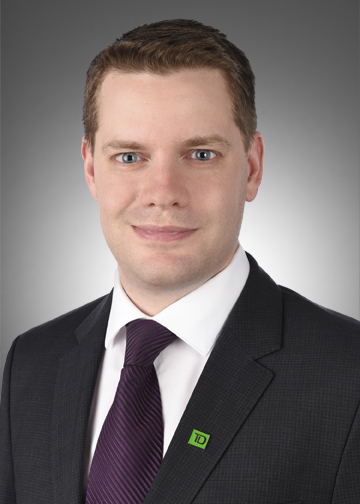
PAID CONTENT
Investment styles and goals differ, but one desire is consistent, says Julien Palardy, a Managing Director at TDAM. “People always love dividends. These stocks tend to be less volatile than non-dividend-paying stocks.”

Managing Director
at TDAM
Palardy’s Quantitative and Passive Investment Team has been around for 25 years. It was one of the first in Canada to focus on quantitative investing. The team has been a leader in alpha strategies and low-volatility strategies, and, more recently, introduced dividend strategies in the form of ETFs.
This lineup includes a Canadian dividend-focused ETF, TD Q Canadian Dividend ETF (TQCD), and a global dividend-focused ETF, TD Q Global Dividend ETF (TQGD). Both provide exposure to high-dividend-paying stocks, with a focus on higher-quality companies that demonstrate growing dividend streams and strong cash flow generation.
What do investors gain through the two ETFs? Palardy discusses the benefits, and the art and science of quantitative investments.
What do TQCD and TQGD add to a portfolio?
Palardy: Our goal is to help ensure investors don’t simply receive dividends today but get sustainable dividends into the future. To help accomplish this, we use quality metrics in our portfolio construction, on top of the dividend yield itself. Stocks must pass at least four out of nine screens, such as an increase in return on assets, whether they’re buying back shares, an increase in asset turnover, and positive operating cash flows.
What are the main allocations for each ETF and why?
Palardy: TQCD and TQGD resemble the composition of the TSX and MSCI World, respectively. However, we have preferences for insurance companies, energy, materials, real estate, and traditional defensives like staples and utilities. In TQGD, we may also find high-quality dividend payers in healthcare, transportation like Japanese rails, and tech, where Apple and Microsoft are our largest positions. Sector allocations are largely driven by where we find dividend-paying stocks, and the names by their quality metrics.
Why are these Canadian and global ETF products better than just buying individual dividend-paying stocks?
Palardy: Diversification matters. Any company can be hit by events that aren’t foreseeable. To identify quality stocks, you need proper risk modelling, and you need to apply a range of metrics across a broad universe.
Are today’s market conditions presenting opportunities in this space?
Palardy: I think it’s a great time for dividend-paying stocks. In today’s markets, investors are going to two extremes on the risk spectrum. At one end are GICs or Treasuries, which pay high yields with zero risk. At the other is a concentrated handful of expensive and volatile stocks. In between, that leaves a lot of high-quality dividend-paying names with significant yields that are at a discount compared to the rest of the market.
Why would investors purchase dividend stocks when they can get 4%-plus, risk-free, in GICs or high-interest savings accounts?
Palardy: Eventually, I believe, interest rates will come down. High-yielding GICs aren’t forever. Dividend-paying stocks, on the other hand, can lock in an opportunity, and right now is an amazing opportunity to buy those at a discounted price.
Why is it often a bad idea to buy the highest-yielding stock on the market?
Palardy: They tend to be lower-quality names, concentrated in too few areas, with a higher probability of dividend cuts in the future. If you maximize the current yield, you won’t necessarily maximize future yield.
How do you view the science of quantitative investing?
Palardy: It’s a sophisticated approach to making use of financial data to help generate excess returns above a market benchmark while managing risk within a portfolio. I believe the future of investing belongs to models and quantitative metrics.
Is a quantitative approach better than passive replication of an index?
Palardy: With passive index replication, your returns are reflective of what the market does. When we build our quantitative ETFs, we have the full firepower of our research and development team, and individuals working on machine learning models to forecast dividend-earnings growth and other metrics that can help identify sustainable winners. We believe we can generate better risk-adjusted returns with this approach.
To build models and select stocks, what skills should you have on a team?
Palardy: When I joined 17 years ago, most people had a background in finance. Now, we also have people with backgrounds in computer science, machine learning, applied math, and neural and cognitive systems. We’re fairly open, as long as individuals have the quantitative skills and are a good complement to the rest of the team.
What quantitative investing myths would you like to dispel?
Palardy: That it’s easy, or a cheap version of investing. A quantitative team is expensive to set up and requires a lot of high-quality data and the proper technology to process it. The talent on the team differs from what you may find on a fundamental equity team, but it’s equally valuable in generating sustainable alpha.
For information about the quant ETFs available at TDAM, download the TD Q Advantage

Commissions, management fees and expenses all may be associated with investments in exchange-traded funds (ETFs). Please read the prospectus and ETF Facts before investing. ETFs are not guaranteed, their values change frequently and past performance may not be repeated. ETF units are bought and sold at market price on a stock exchange and brokerage commissions will reduce returns. TD ETFs are managed by TD Asset Management Inc., a wholly-owned subsidiary of The Toronto-Dominion Bank. ®The TD logo and other TD trademarks are the property of The Toronto-Dominion Bank or its subsidiaries.